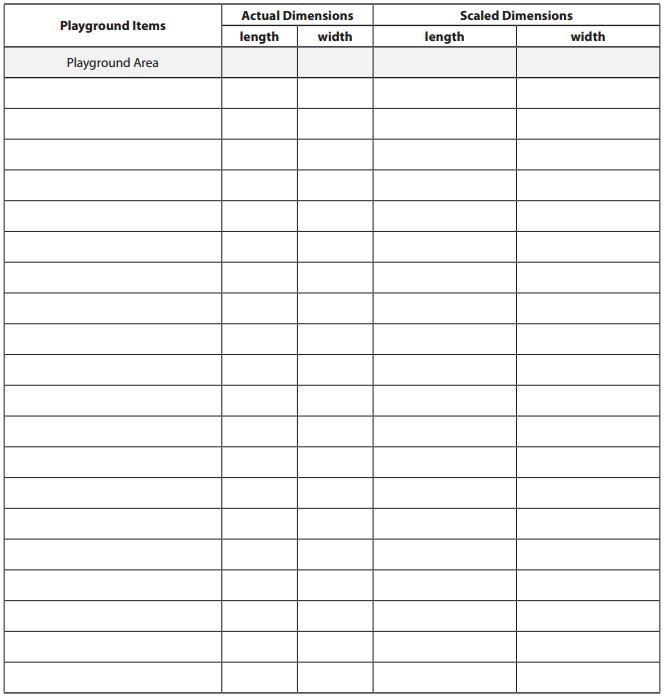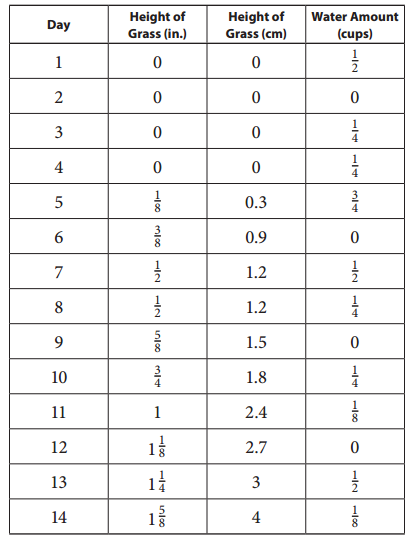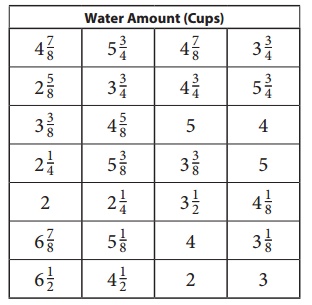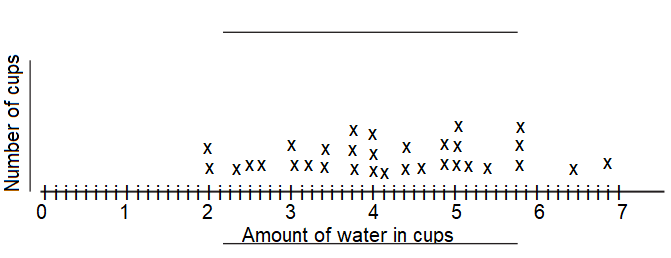Practicing the Bridges in Mathematics Grade 4 Student Book Answer Key Unit 8 Module 3 will help students analyze their level of preparation.
Bridges in Mathematics Grade 4 Student Book Answer Key Unit 8 Module 3
Bridges in Mathematics Grade 4 Student Book Unit 8 Module 3 Session 1 Answer Key
Planning Their Playground
Question 1.
The playground at Ms. Li’s school has a perimeter of 180 meters. What is the largest possible area of the playground? Show your work.
Answer:
2,025 sq meters.
Explanation:
Given that, the playground at school has a perimeter of 180 meters.
The largest possible area of the playground is: Square of length and width of same size 45m
Are of a square A = Side x Side
A = 45 x 45
A = 2,025 sq meters.
Question 2.
Ms. Li’s class is planning a dream playground, and for it they want a play structure that needs 400 square meters of space. If the playground has the area you calculated in item 1, how much room would be left for the other playground items?
Answer:
1,625 sq meters.
Explanation:
As we calculated in the first question, the largest possible area of the playground as,
A = 45 x 45 = 2,025 sq meters.
So, a dream playground want a play structure that needs 400 square meters of space.
Therefore, the room would be left for the other playground items as,
2,025 – 400 = 1,625 sq meters.
Question 3.
The slide Ms. Li’s class wants needs a space of 6 × 15 meters, the swings need 16 × 12 meters, and the climbing wall needs 18 × 9 meters. Sarah says that over half the playground space would be left after these items were installed. Is she correct? Show your reasoning.
Answer:
Yes, she is correct.
Explanation:
The slide needs a space of 6 × 15 = 90 sq meters,
the swings need 16 × 12 = 192 sq meters,
the climbing wall needs 18 × 9 = 162 sq meters.
90 + 192 + 162 = 444 sq meters
Sarah says that over half the playground space would be left after these items were installed.
Bridges in Mathematics Grade 4 Student Book Unit 8 Module 3 Session 2 Answer Key
Scaled Dimensions
Scale Factor:

Scale Factors
Ms. Li’s class is trying to find the scale factor to fit their playground plan on a sheet of one-inch grid paper. The length of their playground is 50 feet and the width is 40 feet. The grid on their grid paper is 8 inches wide and 10 inches tall.
Question 1.
What scale factor should they use? Give reasons for your choice.
Answer:
1 : 5 scale factor.
1 inch : 5 feet.
Explanation:
The length of their playground is 50 feet and the width is 40 feet.
The grid on their grid paper is 8 inches wide and 10 inches tall.
1 inch is equal to 5 ft.
10 inch = 10 x 5 = 50 ft.
8 inch = 8 x 5 = 40 ft.
Question 2.
Ms. Li’s classroom is 32 feet long and 24 feet wide. What scale should her students use to fit a sketch of their classroom on a sheet of their one-inch grid paper?
a. What is the perimeter of Ms. Li’s actual classroom?
Answer:
1 inch = 2 ft.
length = 16 inch.
width = 12 inch.
Explanation:
Given that, the classroom on a sheet of their one-inch grid paper as,
1 inch = 2 ft
length = 16 inch
width = 12 inch
32 feet long and 24 feet wide and the scale should her classroom on a sheet of their one-inch grid paper.
b. What is the perimeter of the scaled drawing of her classroom?
Answer:
192 sq inch.
Explanation:
Given that, the classroom on a sheet of their one-inch grid paper as,
1 inch = 2 ft
length = 16 inch
width = 12 inch
32 feet long and 24 feet wide, the scale should her classroom on a sheet of their one-inch grid paper.
Rectangle of length and width of same size.
A = 16 x 12 = 192 sq inches.
32 feet long and 24 feet wide.
c. How do the two perimeters compare?
Answer:
112 ft.
Explanation:
We know that,
length = 16 inch; width = 12 inch
Perimeter = 2(l + b)
= 2(16 + 12) = 2 x 28 = 56 inches.
We know that,
length = 32 ft; width = 24 ft
Perimeter = 2(l + b)
= 2(32 + 24) = 2 x 56 = 112 ft.
56 x 2 = 112 ft.
Bridges in Mathematics Grade 4 Student Book Unit 8 Module 3 Session 3 & 4 Answer Key
Ever-Growing Grass
Javier continued recording the amount of water he gave his grass and how much it grew.

Question 1.
How much water has Javier given the grass since day 11?
Answer:
3\(\frac{1}{8}\) cups of water.
Explanation:
With reference to the information given in the above table,
\(\frac{1}{2}\) + \(\frac{1}{4}\) + \(\frac{1}{4}\) + \(\frac{3}{4}\) + \(\frac{1}{2}\) + \(\frac{1}{4}\) + \(\frac{1}{4}\) + \(\frac{3}{8}\)
= \(\frac{4}{8}\) + \(\frac{2}{8}\) + \(\frac{2}{8}\) + \(\frac{6}{8}\) + \(\frac{4}{8}\) + \(\frac{2}{8}\) + \(\frac{2}{8}\) + \(\frac{3}{8}\)
= \(\frac{4+2+2+6+4+2+2+3}{8}\)
= \(\frac{25}{8}\)
= 3\(\frac{1}{8}\)
Answer the following questions in both inches and centimeters.
Question 2.
How much did the grass grow between day 11 and day 14?
Answer:
Answer in both inches and centimeters.
\(\frac{5}{8}\) inches
1.6 cm
Explanation:
The grass grow between day 11 and day 14 = 1\(\frac{5}{8}\) – 1
= \(\frac{13}{8}\) – 1
= \(\frac{13- 8}{8}\)
= \(\frac{5}{8}\) inches.
Convert into centimeters.
1 inch = 2.4 cm
4 – 2.4 = 1.6 cm
Question 3.
How much did the grass grow between day 5 and day 14?
Answer:
Answer in both inches and centimeters.
\(\frac{5}{8}\) inches.
3.7 cm.
Explanation:
The grass grow between day 5 and day 14 = 1\(\frac{5}{8}\) – \(\frac{1}{8}\)
= \(\frac{13}{8}\) – \(\frac{1}{8}\)
= \(\frac{13- 1}{8}\)
= \(\frac{12}{8}\)
= 1\(\frac{4}{8}\)
= 1\(\frac{1}{2}\) inches.
Convert inches to centimeters.
4 – 0.3 = 3.7 cm
Bridges in Mathematics Grade 4 Student Book Unit 8 Module 3 Session 4 Answer Key
Water Graph
The tables below show the amounts of water used by the students in Ms. Li’s class.

Question 1.
Draw a line plot showing the amount of water each student used. Give the plot a title and labels.

a. What is the range of the data?
Answer:
4\(\frac{7}{8}\)
Explanation:

Range = 6\(\frac{7}{8}\) – 2
Range =\(\frac{55}{8}\) – 2
Range =\(\frac{55 – 16}{8}\)
Range =\(\frac{39}{8}\)
Range =4\(\frac{7}{8}\)
b. What does the line plot tell you about the data? Write at least two observations. Use another sheet of paper or your math journal if you need more room.
Answer:
minimum 2 cups and maximum 6\(\frac{7}{8}\) cups water is observed.
3 to 5 cups of water is more times observed as per the above plot.
Explanation:

Bridges in Mathematics Grade 4 Student Book Unit 8 Module 3 Session 5 Answer Key
Field Data
Ms. Li’s class found the following measurements for their model grassy field. The dimensions of their new real field will be 150 times as large as the model field they grew.

Question 1.
What are the dimensions of the new field that the parent group intends to fund? Give the dimensions in inches, feet, and yards.
Answer:
Dimensions of new field: 4,500 in by 2,250 in.
Explanation:

We know the old field dimensions are: 30 in by 15 in.
Given, new real field will be 150 times as large as the model field they grew.
So, the dimensions of new field: 4,500 in by 2,250 in.
Dimensions in feet:
1 ft = 12 in
4,500 x 12 = 54,000 ft
2,250 x 12 = 27,000 ft
So, dimensions in feet are: 54,000 ft by 27,000 ft.
Dimensions in Yards:
1 feet = 0.33 yard
54,000 x 0.33 = 17,820 yd
27,000 x 0.33 = 8,910 yd
So, dimensions in yards are: 17,820 yd by 8,910 yd.
Question 2.
What is the area of the new field in square yards? Show all your work.
Answer:
273,375 sq yd.
Explanation:
We know the area of old filed as 450 sq in.
The area of the real field in square yards.
4,500 x 2,250 = 10,125,000 sq in.
1 in = 0.027 yd
10,125,000 x 0.027 = 273,375 sq yd.
Question 3.
What is the mass of the soil needed for the new field? Give the mass in kilograms.
Answer:
810 kg
Explanation:
We know the mass of old field as 5,400 gm.
1kg = 1000 gm
5400 by 1000 = 5.4 kg
5.4 x 150 = 810 kg
So, the mass of the soil needed for the new field is 810 kg.
Bridges in Mathematics Grade 4 Student Book Unit 8 Module 3 Session 6 Answer Key
New Field Costs
The parents’ group needs information about the cost of the new field. They gathered the following information for the cost of soil, water, and grass seed.
- soil – $3.00 per 100 kilograms
- grass seed – $1.00 per 1000 square yards
- water – 1 cent per gallon
Question 1.
Determine the cost of soil needed for the new field. Show all of your work.
Answer:
$2,430
Explanation:
With reference to the above information cost of old soil is $3.00 per kilogram.
we know the mass of the new field soil as 810 kg
So, the cost of new field = 810 x 3.00 = $2,430
Question 2.
Determine the cost of the grass seed needed for the new field. Show all of your work.
Answer:
$273375
Explanation:
With reference to the above information the area of the new field is 273,375 sq yd.
Cost of grass weed $1.00 per 1000 square yards.
So, 273.375 x 1 = $273375
Question 3.
Determine the cost of the water needed for the new field for the tending period. Show all of your work.
Answer:
$9
Explanation:
With reference to the above given information,
the water needed for the new field for the tending period is 900 gallons.
Cost of water = 1 cent per gallon
So, 900 x 1 = 900 cents.
1 dollar = 100 cents.
So, 9 dollars.
Question 4.
What is the total cost for planting the new field? Show all of your work.
Answer:
$275,814
Explanation:
With reference to the above information, we know
the cost of water = $9
cost of grass weed = $273375
cost of soil = $2,430
So, the total cost for planting the new field = 9 + 273375 + 2430 = $275,814
Question 5.
Can you think of any additional costs the parents’ group might need to consider?
Answer:
Answer may vary.
Explanation:
Might be the parents may need to know the cost of area of the field.
Question 6.
Write down any additional information you would need to write a letter to the parents’ group. The letter will tell them how much they should budget for the new field and why.
Answer:
Answer may vary.
Explanation:
The parents should budget for the new field according to their requirements.
Another New Playing Field
Ms. Li’s class needs to find the cost of planting their new playing field. They gathered this information about their model field:

They gathered the following information about the cost of the soil and grass seed:
- soil – $3.00 per 100 kilograms
- grass seed – $1.00 per 1000 square yards
- water – 1 cent per gallon
Question 1.
How much will the soil for the new field cost? Show your work.
Answer:
$2,430
Explanation:

With reference to the above information cost of old soil is $3.00 per kilogram.
we know the mass of the new field soil as 810 kg
So, the cost of new field = 810 x 3.00 = $2,430
Question 2.
Determine the cost of the grass seed needed for the new field.
Answer:
$273375
Explanation:
With reference to the above information the area of the new field is 273,375 sq yd.
Cost of grass weed $1.00 per 1000 square yards.
So, 273.375 x 1 = $273375
Question 3.
How much will the water cost that they’ll use to water the field for 2 weeks?
Answer:
$9
Explanation:
With reference to the above given information,
the water needed for the new field for the tending period is 900 gallons.
Cost of water = 1 cent per gallon
So, 900 x 1 = 900 cents.
1 dollar = 100 cents.
So, 9 dollars.
Question 4.
What is the total cost for planting the new field?
Answer:
$275,814
Explanation:
With reference to the above information, we know
the cost of water = $9
cost of grass weed = $273375
cost of soil = $2,430
So, the total cost for planting the new field = 9 + 273375 + 2430 = $275,814